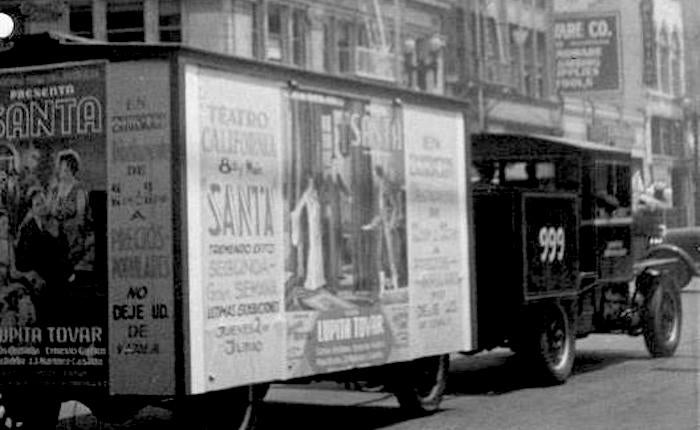
Casta de roble (1954)
Two days ago the Getty Foundation officially announced implementation funding for Pacific Standard Time: LA/LA, a far-reaching and ambitious exploration of Latin American and Latino art in dialogue with Los Angeles, taking place from September 2017 through January 2018 at more than 60 cultural institutions across Southern California.
I’m proud to share that UCLA Film & Television Archive was awarded a $200,000 grant. As a result, the Archive will stage Recuerdos de un cine en español: Latin American Cinema in Los Angeles, 1930-1960, in the fall of 2017, screening films at both the Billy Wilder Theater and a downtown L.A. venue. As a prequel to the Getty-led initiative, the Archive will – in conjunction with our FIAF partners, the Academy Film Archive and The Packard Humanities Institute – also stage a symposium during the 2017 conference in Los Angeles on “Spanish Language Film Production in Hollywood,” which is also partially funded by the Getty Foundation. While many Pacific Standard Time: LA/LA projects are bringing Latin American art to Los Angeles, the Archive is attempting to recuperate a native California Spanish-language culture that was always at home in Los Angeles, and continues to be through local Spanish-language television, but has – like its population – been hidden from the view of the so-called “mainstream.” There are complex reasons for this previous neglect.

Million Dollar Theatre in downtown Los Angeles
For much of the 20th century, the classic cinemas of Argentina, Mexico and Cuba were invisible in film studies and the general histories of film, which steadfastly focused on U.S. and European film production prior to WWII. Indeed, with the exception of the Mexican films of Luis Buñuel, world cinema histories by Paul Rotha, Georges Sadoul, Jack Ellis, David Robinson, Robert Sklar and others marginalized Latin American film production altogether, at least until the cinema nuovo and other Latin American liberation movements in the 1960s and 1970s demanded attention from a new generation of film art-oriented historians and critics. The films made in these countries prior to the rise of the “Third Cinema” were considered pale imitations of Hollywood fare and therefore not worthy of serious consideration, because they employed narrative structures now associated with classical Hollywood narrative (as understood by Bordwell and Thompson), generic formulas and local film stars. Typical is the statement by Paul Rotha: “it is disappointing that more has not been developed in the way of good cinema (in Latin America). This is particularly true of Mexico. The fact remains that although Mexican producers turn out a hundred or more feature films a year, very few indeed have commanded interest […]”
It has only been in the past 15 years that a number of scholars have moved beyond this narrow view to begin exploring the cultural specificity of classic Latin American cinema. First and foremost Ana M. López, who argues that there is a prejudice against genre in discussing this cinema, even while the same scholars valorize Hollywood genre cinema, in her essay “Tears and Desire: Women and Melodrama in the ‘Old’ Mexican Cinema.” Meanwhile, the prejudice against pre-revolutionary Cuban cinema has been ideological. Michael Chanan’s statement in The Cuban Image is typical of critical attitudes among academics, as well as in the Cuban government: “Cuba cannot be said to have had an indigenous film industry before the revolution of 1959. The melodramas, musicals, and comedies [at least 80 feature films!] made until then reflected Hollywood's – and the United States’ – cultural domination of the island […]”

Advertising for the Teatro California's presentation of Santa (1932)
However, there is a second more insidious reason for the disappearance, specifically in Los Angeles, of a local, mostly Mexican film culture. In the aftermath of WWII, a vibrant cinema culture all but disappeared in Los Angeles in the wake of the urban renewal of North Main Street’s Mexican neighborhoods. “Urban renewal” was the code word for removal of non-white populations from L.A., making the city “safe” for new Caucasian migrants from the East. Previously, Spanish-language cinema had thrived in the city’s downtown theaters, screening throughout the 1930s, 1940s and 1950s in venues such as the Teatro Eléctrico, the California, the Mason, the Million Dollar and the Roosevelt, among many others. The great majority of these films originated from Mexico, Argentina and Cuba, which maintained their own national film industries. Furthermore, Los Angeles served as a center of production for select Spanish-language films, and was a major distribution center for motion pictures coming from Latin America and going to over 500 theaters in the U.S. Not only have the cinemas disappeared, except for the Million Dollar Theatre on Broadway, but virtually all of the films have also fallen out of history, for the most part unpreserved or tragically lost, their memory undocumented in film histories.
With Recuerdos de un cine en español, we hope that audiences and film historians will rediscover Los Angeles as one of the most important hubs for the production, distribution and exhibition of films made in Spanish for Latin American audiences. In order to accomplish this task, the Archive will have to preserve many of the films being screened. But more about those efforts in a future blog.
Pacific Standard Time is an initiative of the Getty. The presenting sponsor is Bank of America. Learn more >
< Back to Archival Spaces blog






 Mobile Navigation
Mobile Navigation

